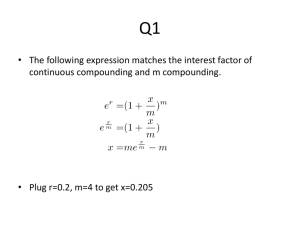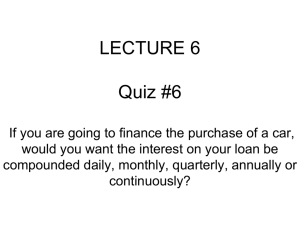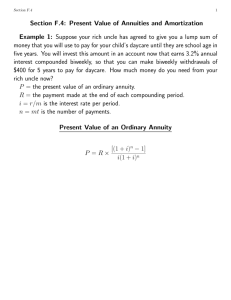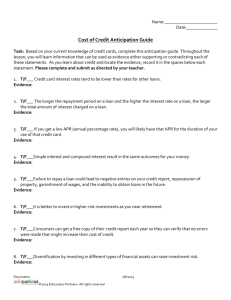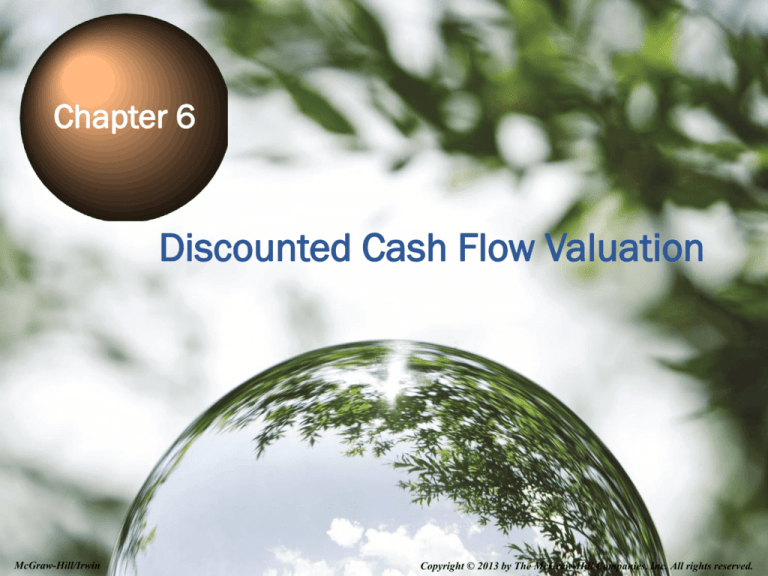
Chapter 6
Discounted Cash Flow Valuation
6-1
McGraw-Hill/Irwin
Copyright © 2013 by The McGraw-Hill Companies, Inc. All rights reserved.
Chapter Outline
• Multiple Cash Flows: Future and
Present Values
• Multiple Equal Cash Flows: Annuities
and Perpetuities
• Comparing Rates: the Effect of
Compounding
• Loan Types
• Loan Amortization
6-2
Chapter Outline
• Multiple Cash Flows: Future and
Present Values
• Multiple Equal Cash Flows: Annuities
and Perpetuities
• Comparing Rates: the Effect of
Compounding
• Loan Types
• Loan Amortization
6-3
Single Cash Flows
In the previous chapter, we used single cash
flows and moved them forward and backward
in time.
Today
PV
Today
6-4
PV
1
2
3
4
Compounding
1
2
3
Discounting
4
5
FV
5
FV
Multiple Cash Flows
What if we have more than
one cash flow?
The concept (and
formula) are identical
if we simply look at the
problem as a series of
single payments.
6-5
Multiple Cash Flows
Future Value 1
Suppose you have $1,000 now in a savings account
that is earning 6%. You want to add $500 one year
from now and $700 two years from now.
Today
$1,000
1 Year
$500
2 Years
$700
How much will you have two years from now in your
savings account (after you make your $700 deposit)?
6-6
Multiple Cash Flows
Future Value 1
Simply look at each payment separately and move
them through time as we did in the earlier chapter.
Today
$1,000
6-7
1 Year
$ 500
Now just add them up
because they are all
adjusted to be in “year 3” value
2 Years
$ 700
$1,124
$ 530
$2,354
TI BA II Plus
1123.60
2 years = N
6% = I/Y
-$1,000 = PV
CPT
1st
? = FV
2nd
6-8
2 years = N
HP
6% = i
-$1,000 = PV
12-C
? = FV
1123.60
6-9
Multiple Cash Flows
Future Value 1B
Could we do this problem another way?
Bring each of the cash flows forward one year at a
time and add them up each year.
Today
$1,000
6-10
1 Year
$ 500
$1,060
$1,560
2 Years
$ 700
$1,654
$2,354
Multiple Cash Flows
Future Value 1C
Let’s add one more twist to the problem:
What would be the value at year 5 if we made no
further deposits into our savings account?
Today
1
2
$1,000 500 700
6-11
3
4
5
Multiple Cash Flows
Future Value 1C
We could do this two different ways:
1.
Bring the “year two” figure we
previously produced to year five
Today
1
2
$1,000 500 700
$2,354
6-12
3
4
5
$2,803
Multiple Cash Flows
Future Value 1C
We could do this two different ways:
2.
Bring each of the three original
dollars to year 5 and add them all up.
Today
1
2
$1,000 500 700
6-13
3
4
5
$1,338
$ 631
$ 833
$2,803
Multiple Cash Flows
Present Value
To compute the present value of
multiple cash flows, we again just
bring the payments into the
present value – one year at a time.
6-14
Multiple Cash Flows
Present Value - 1
6-15
Consider receiving the following
cash flows:
Year 1 CF = $200
Year 2 CF = $400
Year 3 CF = $600
Year 4 CF = $800
If the discount rate is 12%, what
would this cash flow be worth
today?
Multiple Cash Flows
Present Value - 1
Visually, the time line
would look like this:
Today
6-16
1
2
3
4
200
400
600
800
Multiple Cash Flows
Present Value - 1
To compute the present value of this future
stream of cash, we just take each year to the
present, one at a time:
6-17
Today
1
2
3
4
178.57
318.88
427.07
508.41
1,432.93
200
400
600
800
Multiple Cash Flows
Present Value -1
Using a calculator, find the PV of each cash
flow and just add them up!
Year 1 CF: N = 1; I/Y = 12; FV = 200; CPT PV = -178.57
Year 2 CF: N = 2; I/Y = 12; FV = 400; CPT PV = -318.88
Year 3 CF: N = 3; I/Y = 12; FV = 600; CPT PV = -427.07
Year 4 CF: N = 4; I/Y = 12; FV = 800; CPT PV = - 508.41
Total PV = 178.57 + 318.88 + 427.07 + 508.41 = $1,432.93
6-18
Multiple Cash Flows Using a
Spreadsheet
You can use the PV or FV functions in Excel to
find the present value or future value of a set of
cash flows
Setting the data up is half the battle – if it is set up
properly, then you can just copy the formulas
Click on the Excel icon for an example
6-19
Multiple Cash Flows
Present Value - 2
You are considering an investment that will pay you
$1,000 in one year, $2,000 in two years and $3,000 in three
years. If you want to earn 10% on your money, how much
would you be willing to pay?
N = 1; I/Y = 10; FV = 1,000; CPT PV = -909.09
N = 2; I/Y = 10; FV = 2,000; CPT PV = -1,652.89
N = 3; I/Y = 10; FV = 3,000; CPT PV = -2,253.94
PV = 909.09 + 1,652.89 + 2,253.94 = 4,815.93
6-20
Multiple Uneven Cash Flows
Using the TI BA II + Calculator
Another way to use the financial calculator for
uneven cash flows is to use the cash flow keys
1.
2.
3.
4.
5.
6.
6-21
Press CF and enter the cash flows beginning with year 0.
You have to press the “Enter” key for each cash flow
Use the down arrow key to move to the next cash flow
The “F” is the number of times a given cash flow occurs in consecutive
periods
Use the NPV key to compute the present value by entering the
interest rate for I, press “Enter”, then the down arrow, and then “CPT”
computing the answer
Clear the cash flow worksheet by pressing CF and then 2nd CLR Work
Decisions, Decisions
Your broker calls you and tells you that he has this great
investment opportunity. If you invest $100 today, you will
receive $40 in one year and $75 in two years. If you require a
15% return on investments of this risk, should you take the
investment?
Use the CF keys to compute the present value of the
proposed investment’s cash flows
CF; CF0 = 0; C01 = 40; F01 = 1; C02 = 75; F02 = 1
NPV; I = 15; CPT NPV = $91.49
No! – the broker is charging more than you would be willing
to pay ($100 versus the PV of $91.49)
6-22
TI BA II Plus
91.49
6-23
CF
0 = CF0 ; ↓
40 = CO1; ↓
1 = FO1; ↓
75 = CO2; ↓
1 = FO2; ↓
NPV
15 = I/Y
1st
↓
2nd
CPT
Multiple Uneven Cash Flows
Using the HP 12c Calculator
Another way to use the financial calculator for
uneven cash flows is to use the cash flow keys
1.
2.
3.
4.
5.
6-24
CF = 0 and then press “g” + CF0.
Enter each cash flow separately followed by “g” + CFj
Enter the interest rate and press the “i” key.
To obtain the NPV, press “f ” + NPV keys
Clear the cash flow worksheet by pressing “f ” and then
CLX
Decisions, Decisions
Your broker calls you and tells you that he has this great
investment opportunity. If you invest $100 today, you will
receive $40 in one year and $75 in two years. If you require a
15% return on investments of this risk, should you take the
investment?
Use the CF keys to compute the present value of the
proposed investment’s cash flows
“g” CF0 = 0; “g” CFj = 40; “g” CFj = 75
i = 15; “f ” NPV = 91.49
No! – the broker is charging more than you would be willing
to pay ($100 versus the PV of $91.49)
6-25
0 = CF0
HP
40 = CFj
75 = CFj
15% = i
91.49
6-26
12-C
? = NPV
Quick Quiz I
Suppose you are looking at the following possible cash
flows: Year 1 CF = $100; Years 2 and 3 CFs = $200; Years 4
and 5 CFs = $300. The required discount rate is 7%.
What is the value of the cash flows
at year 5?
What is the value of the cash flows today?
What is the value of the cash flows
at year 3?
6-27
Chapter Outline
• Multiple Cash Flows: Future and
Present Values
• Multiple Equal Cash Flows: Annuities
and Perpetuities
• Comparing Rates: the Effect of
Compounding
• Loan Types
• Loan Amortization
6-28
Annuities and Perpetuities
Definitions
Annuity – finite series of equal payments
that occur at regular intervals
If the first payment occurs at the end of the period, it is called
an ordinary annuity
If the first payment occurs at the beginning of the period, it is
called an annuity due
Perpetuity – infinite series of equal
payments
6-29
Annuities and Perpetuities
Basic Formulas
Perpetuity:
Annuity:
PV = C / r
1
1
(1 r ) t
PV C
r
(1 r ) t 1
FV C
r
6-30
Annuities on the
Spreadsheet - Example
The present value and future value
formulas in a spreadsheet include a
place for annuity payments
Click on the Excel icon to see an
example
6-31
Annuities and the Calculator
You can use the PMT key on the calculator for
equal payments
6-32
Annuities and the Calculator
Ordinary annuity versus annuity due
TI BA II Plus: You can switch your calculator between the
two types by using the 2nd BGN 2nd Set on the TI BA-II Plus
HP 12C: “g” 7 sets the calculator for Beginning and “g” 8
for End.
If you see “BGN” or “Begin” in the display of your
calculator, you have it set for an annuity due
Most problems are
ordinary annuities
6-33
Annuity: Saving for a Car
After carefully going over your
budget, you have determined you can
afford to pay $632 per month towards
a new sports car. You call up your
local bank and find out that the
going rate is 1 percent per month for
48 months. How much can you
borrow?
6-34
Annuity: Saving for a Car
You borrow money TODAY so you
need to compute the present value.
48 N; 1 I/Y; -632 PMT; CPT PV = 23,999.54 ($24,000)
Formula:
6-35
1
1 (1.01) 48
PV 632
23,999.54
.01
Annuity: Sweepstakes Winner
Suppose you win the Publishers Clearinghouse $10
million sweepstakes. The money is paid in equal
annual end-of-year installments of $333,333.33 over 30
years.
If the appropriate discount rate is 5%,
how much is the sweepstakes actually
worth today?
6-36
Saving For Retirement
You are offered the opportunity to put
some money away for retirement. You
will receive five annual payments of
$25,000 each, beginning in 40 years.
How much would
you be willing to
invest today if you
desire an interest
rate of 12%?
6-37
Saving For Retirement
Timeline
6-38
0 1 2
…
39
0 0 0
…
0
40
41
42
43
44
25K 25K 25K 25K 25K
Annuity: Buying a House
You are ready to buy a house, and you have $20,000 for
a down payment and closing costs. Closing costs are
estimated to be 4% of the loan value. You have an
annual salary of $36,000, and the bank is willing to
allow your monthly mortgage payment to be equal to
28% of your monthly income.
6-39
Annuity: Buying a House
(Continued)
The interest rate on the loan is 6% per year with
monthly compounding (.5% per month) for a 30-year
fixed rate loan.
1. How much money will the bank loan you?
2. How much can you offer for the house?
6-40
Annuity: Buying a House Continued
Bank loan
Monthly income = 36,000 / 12 = 3,000
Maximum payment = .28(3,000) = 840
30*12 = 360 N
.5 I/Y
-840 PMT
CPT PV = $140,105
Total Price
Closing costs = .04(140,105) = 5,604
Down payment = 20,000 – 5,604 = 14,396
Total Price = 140,105 + 14,396 = $154,501
6-41
Quick Quiz II
1. You know the payment amount for a loan, and you
want to know how much was borrowed. Do you
compute a present value or a future value?
2. You want to receive 5,000 per month in retirement. If
you can earn 0.75% per month and you expect to need
the income for 25 years, how much do you need to
have in your account at retirement?
6-42
Finding the Payment
Suppose you want to borrow $20,000 for a new car. You
can borrow at 8% per year, compounded monthly
(8/12 = .66667% per month).
If you take a 4-year loan, what is your monthly
payment?
4(12) = 48 N; 20,000 PV; .66667 I/Y;
CPT PMT = $488.26
6-43
Finding the Payment on a
Spreadsheet
Another TVM formula that can be
found in a spreadsheet is the payment
formula:
PMT(rate,nper,pv,fv)
(The same sign convention holds as for the
PV and FV formulas)
6-44
Click on the Excel icon for an
example
Finding the Number of Payments I
You ran a little short on your spring break
vacation, so you put $1,000 on your credit
card. You can only afford to make the
minimum payment of $20 per month. The
interest rate on the credit card is 1.5
percent per month.
How long will you need to pay off the
$1,000?
6-45
Finding the Number of Payments I
The sign convention matters!
1.5 I/Y
1,000 PV
-20 PMT
CPT N = 93.111 MONTHS = 7.75 years
And this is only if you don’t charge
anything more on the card!
6-46
Finding the Number of Payments II
Suppose you borrow $2,000 at 5%, and you
are going to make annual payments of
$734.42.
How long before you pay off the loan?
(the sign convention matters!)
5 I/Y
2,000 PV
-734.42 PMT
CPT N = 3 years
6-47
Chapter Outline
• Multiple Cash Flows: Future and
Present Values
• Multiple Equal Cash Flows: Annuities
and Perpetuities
• Comparing Rates: the Effect of
Compounding
• Loan Types
• Loan Amortization
6-48
Finding the Rate
Suppose you borrow $25,000 from your parents to buy a
car. You agree to pay $207.58 per month for 60 months.
What is the monthly interest rate?
(The sign convention matters!)
60 N
25,000 PV
-207.58 PMT
CPT I/Y = 2.05%
6-49
Annuity – Finding the Rate
Without a Financial Calculator
Trial and Error Process (ugh!)
1.
2.
3.
4.
5.
6-50
Choose an interest rate and compute the PV of the
payments based on this rate
Compare the computed PV with the actual loan
amount
If the computed PV > loan amount, then the interest
rate is too low
If the computed PV < loan amount, then the interest
rate is too high
Adjust the rate and repeat the process until the
computed PV and the loan amount are equal
Quick Quiz III
You want to receive $5,000 per month for the next 5 years.
How much would you need to deposit today if you can earn
0.75% per month?
2. What monthly rate would you need to earn if you only have
$200,000 to deposit?
Suppose you have $200,000 to deposit and can earn 0.75% per
month.
1. How many months could you receive the $5,000 payment?
2. How much could you receive every month for 5 years?
1.
6-51
Future Values for Annuities
Suppose you begin saving for your retirement by
depositing $2,000 per year in an IRA. If the interest rate
is 7.5%, how much will you have in 40 years?
(Remember the sign convention!)
40 N
7.5 I/Y
-2,000 PMT
CPT FV = $454,513.04
6-52
Annuity Due
You are saving for a new house and you need 20%
down to get a loan. You put $10,000 per year in an
account paying 8%. The first payment is made today.
How much will you have at the end of 3 years
(you make a total of three $10,000 payments)?
6-53
2nd BGN 2nd Set (you should see BGN in the display)
3N
-10,000 PMT
8 I/Y
CPT FV = $35,061.12
(“2nd BGN 2nd Set” needs to be changed back to an
ordinary annuity when you are finished)
Annuity Due Timeline
0
10000
1
10000
2
3
10000
32,464
35,016.12
6-54
Perpetuity
Perpetuity formula: PV = C / r
Current required return:
40 = 1 / r
r = .025 or 2.5% per quarter
Dividend for new preferred:
100 = C / .025
C = 2.50 per quarter
6-55
Perpetuity Example
Suppose the Fellini Company wants to sell
preferred stock at $100 per share. A similar
issue of preferred stock already outstanding
has a price of $40 per share and offers a
dividend of $1 every quarter.
What dividend will Fellini have to offer if the
preferred stock is going to sell?
6-56
Quick Quiz IV
1.
2.
3.
6-57
You want to have $1 million to use for
retirement in 35 years. If you can earn
1% per month, how much do you need
to deposit on a monthly basis if the
first payment is made in one month?
What if the first payment is made
today?
You are considering preferred stock
that pays a quarterly dividend of $1.50.
If your desired return is 3% per
quarter, how much would you be
willing to pay?
Terms and Formulas
6-58
Effective Annual Rate (EAR)
This is the actual rate paid (or received) after
accounting for compounding that occurs during
the year
If you want to compare two alternative investments
with different compounding periods, you need to
compute the EAR and use that for comparison.
6-59
Annual Percentage Rate (APR)
This is the annual rate that is
quoted by law on all loans.
By definition: APR = period rate
times the number of periods per
year
6-60
Annual Percentage Rate (APR)
Consequently, to get the period rate we rearrange the
APR equation:
Period rate = APR / number of
periods per year
You should NEVER divide the effective rate by the
number of periods per year – it will NOT give you the
period rate
6-61
Computing APRs
1.
What is the APR if the monthly rate is .5%?
.5(12) = 6%
2.
What is the APR if the semiannual rate is .5%?
.5(2) = 1%
3.
What is the monthly rate if the APR is 12% with
monthly compounding?
12 / 12 = 1%
6-62
Things to Remember
You ALWAYS need to make sure
that the interest rate and the
time period match.
If you are looking at annual
6-63
periods, you need an annual
rate.
If you are looking at monthly
periods, you need a monthly
rate.
Things to Remember
If you have an APR based on
monthly compounding, you
have to use monthly periods for
lump sums, or adjust the
interest rate appropriately if
you have payments other than
monthly
6-64
Computing EARs Example
Suppose you can earn 1% per month on $1
invested today.
What is the APR?
1(12) = 12%
How much are you effectively earning?
FV = 1(1.01)12 = 1.1268
Rate = (1.1268 – 1) / 1
= .1268 = 12.68%
6-65
Computing EARs Example
(continued)
Suppose you put it in another account
and earn 3% per quarter.
What is the APR?
3(4) = 12%
How much are you effectively earning?
FV = 1(1.03)4 = 1.1255
Rate = (1.1255 – 1) / 1
= .1255 = 12.55%
6-66
EAR - Formula
Remember that the APR is the quoted
rate, and
6-67
“m” is the number of compounding
periods per year
Decisions, Decisions II
You are looking at two savings accounts. One pays 5.25%,
with daily compounding. The other pays 5.3% with
semiannual compounding.
Which account should you use?
First account:
EAR = (1 + .0525/365)365 – 1 = 5.39%
Second account:
EAR = (1 + .053/2)2 – 1 = 5.37%
Which account should you choose and why?
6-68
Decisions, Decisions II
Continued
Let’s verify the choice. Suppose you
invest $100 in each account. How much
will you have in each account in one year?
First Account:
365 N; 5.25 / 365 = .014383562 I/Y; 100 PV;
CPT FV = $105.39
Second Account:
2 N; 5.3 / 2 = 2.65 I/Y; 100 PV; CPT FV = $105.37
You have more money in the first account.
6-69
Computing APRs from EARs
If you have an effective rate, how can you
compute the APR? Rearrange the EAR equation
and you get:
6-70
APR - Example
Suppose you want to earn an effective rate of 12%
and you are looking at an account that compounds
on a monthly basis. What APR must they pay?
6-71
Computing Payments with APRs
Suppose you want to buy a new computer system and
the store is willing to allow you to make monthly
payments. The entire computer system costs $3,500.
The loan period is for 2 years, and the interest rate is
16.9% with monthly compounding.
What is your monthly payment?
2(12) = 24 N; 16.9 / 12 = 1.408333333 I/Y; 3,500 PV; CPT PMT = $172.88
6-72
Future Values with Monthly
Compounding
Suppose you deposit $50 a month into an account that
has an APR of 9%, based on monthly compounding.
How much will you have in the account in 35 years?
35(12) = 420 N
9 / 12 = .75 I/Y
50 PMT
CPT FV = $147,089.22
6-73
Present Value with Daily
Compounding
You need $15,000 in 3 years for a new car. If you
can deposit money into an account that pays an
APR of 5.5% based on daily compounding, how
much would you need to deposit?
3(365) = 1,095 N
5.5 / 365 = .015068493 I/Y
15,000 FV
CPT PV = -$12,718.56
6-74
Quick Quiz V
What is the definition of an APR?
What is the effective annual rate?
Which rate should you use to compare
alternative investments or loans?
Which rate do you need to use in the
time value of money calculations?
6-75
Chapter Outline
• Multiple Cash Flows: Future and
Present Values
• Multiple Equal Cash Flows: Annuities
and Perpetuities
• Comparing Rates: the Effect of
Compounding
• Loan Types
• Loan Amortization
6-76
Types of Loans
• Pure Discount Loan
• Interest-only Loan
• Amortized with Fixed Principal
payment
• Amortized with Fixed Payment
6-77
Pure Discount Loans
Treasury bills are excellent examples of pure discount
loans. The principal amount is repaid at some future
date, without any periodic interest payments.
6-78
Pure Discount Loans
If a T-bill promises to repay $10,000 in 12 months
and the market interest rate is 7 percent, how
much will the bill sell for in the market?
1 N; 10,000 FV; 7 I/Y; CPT PV = -$9,345.79
6-79
Chapter Outline
• Multiple Cash Flows: Future and
Present Values
• Multiple Equal Cash Flows: Annuities
and Perpetuities
• Comparing Rates: the Effect of
Compounding
• Loan Types
• Loan Amortization
6-80
Amortized Loan with Fixed
Principal Payment - Example
Consider a $50,000, 10 year loan at
8% interest. The loan agreement
requires the firm to pay $5,000 in
principal each year plus interest for
that year.
Click on the Excel icon to see the
amortization table
6-81
Amortized Loan with Fixed
Payment - Example
Each payment covers the interest expense plus
reduces principal
Consider a 4 year loan with annual payments. The
interest rate is 8%, and the principal amount is $5,000.
What is the annual payment?
4N
8 I/Y
5,000 PV
CPT PMT = -$1,509.60
6-82
Click on the Excel icon to see the
amortization table
Comprehensive Problem Part 1
An investment will provide you with
$100 at the end of each year for the next
10 years. What is the present value of
that annuity if the discount rate is 8%
annually?
What is the present value of the above if
the payments are received at the
beginning of each year?
6-83
Comprehensive Problem Part 2
If you deposit those payments into an
account earning 8%, what will the
future value be in 10 years?
What will the future value be if you
open the account with $1,000 today, and
then make the $100 deposits at the end
of each year?
6-84
Terminology
•
•
•
•
•
•
•
•
6-85
Present value of multiple cash flows
Future value of multiple cash flows
Annuity
Annuity Due
Perpetuity
Effective Annual Rate (EAR)
Annual Percentage Rate (APR)
Continuous Compounding
Terminology
(continued)
•
•
•
•
6-86
Pure Discount Loan
Interest-only Loan
Amortized Loan with Fixed Principle
Amortized Loan with Fixed Payment
Formulas
Perpetuity:
Annuity:
6-87
PV = C / r
1
1 (1 r ) t
PV C
r
(1 r ) t 1
FV C
r
Formulas
(continued)
t
(1 g )
C
PV
1
r g (1 r )
C
PV
rg
6-88
Formulas
(continued)
m
APR
EAR 1
1
m
APR m (1 EAR)
6-89
1
m
-1
Key Concepts and Skills
• Compute the future value
of multiple cash flows
• Compute the present value
of multiple cash flows
• Distinguish between an ordinary
annuity and an annuity due
6-90
Key Concepts and Skills
• Compute loan payments
• Find the interest rate
on a loan
• Explain how interest rates are quoted
• Give examples of different ways a loan
can be paid off
6-91
What are the most important
topics of this chapter?
1. Multiple cash flows are moved both
forward in time and into present value
just like single payments.
2. Annuities are a special case of multiple
cash flows in that they are a “fixed,
equal, uninterrupted series of
payments or receipts”.
6-92
What are the most
important topics of this
chapter?
3. Effective Annual Rate and Annual
Percent Rate are two methods to
determine the cost of a loan.
4. Loans can be pure discount, interestonly, or amortized – with fixed
principal or fixed payments.
6-93
6-94


